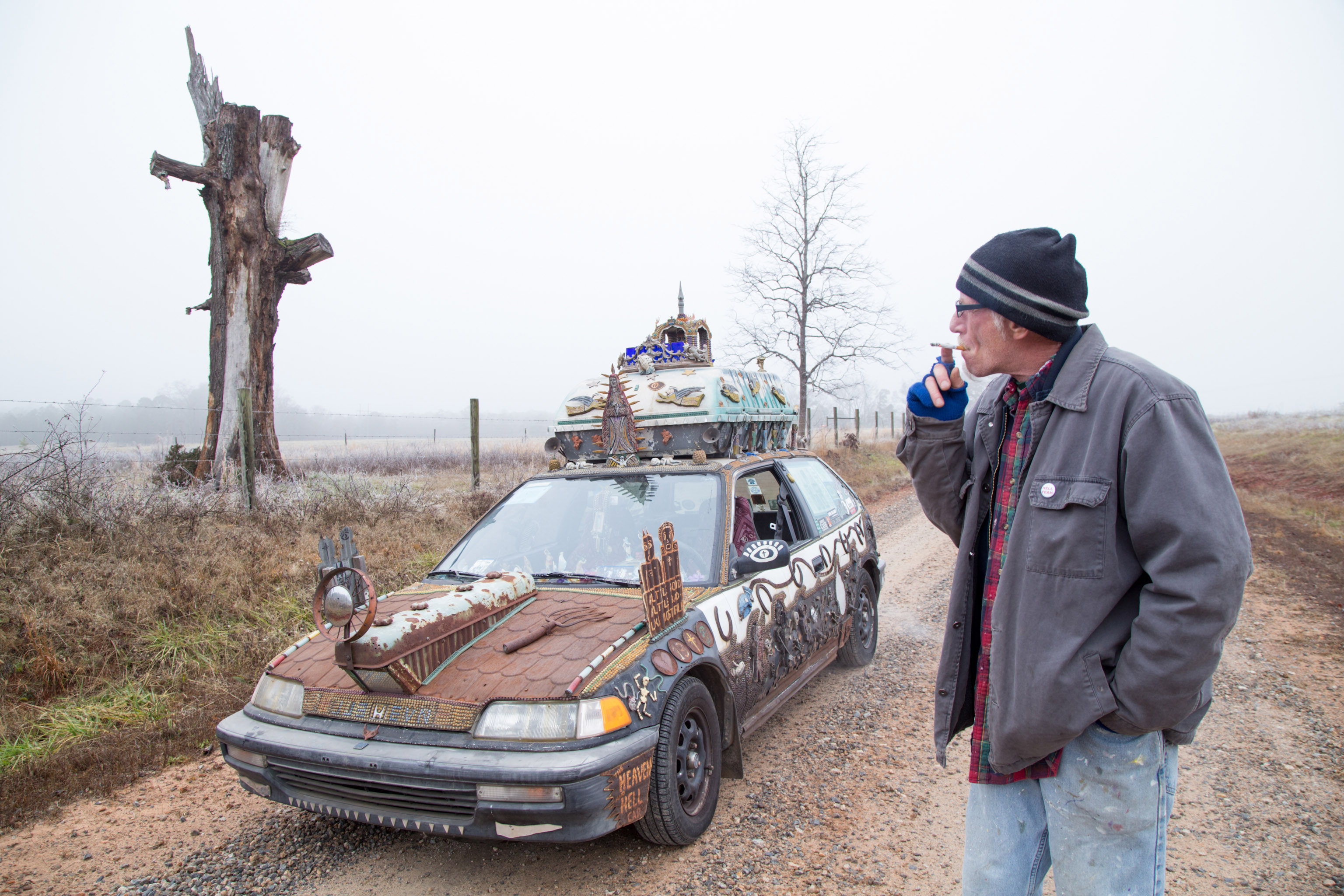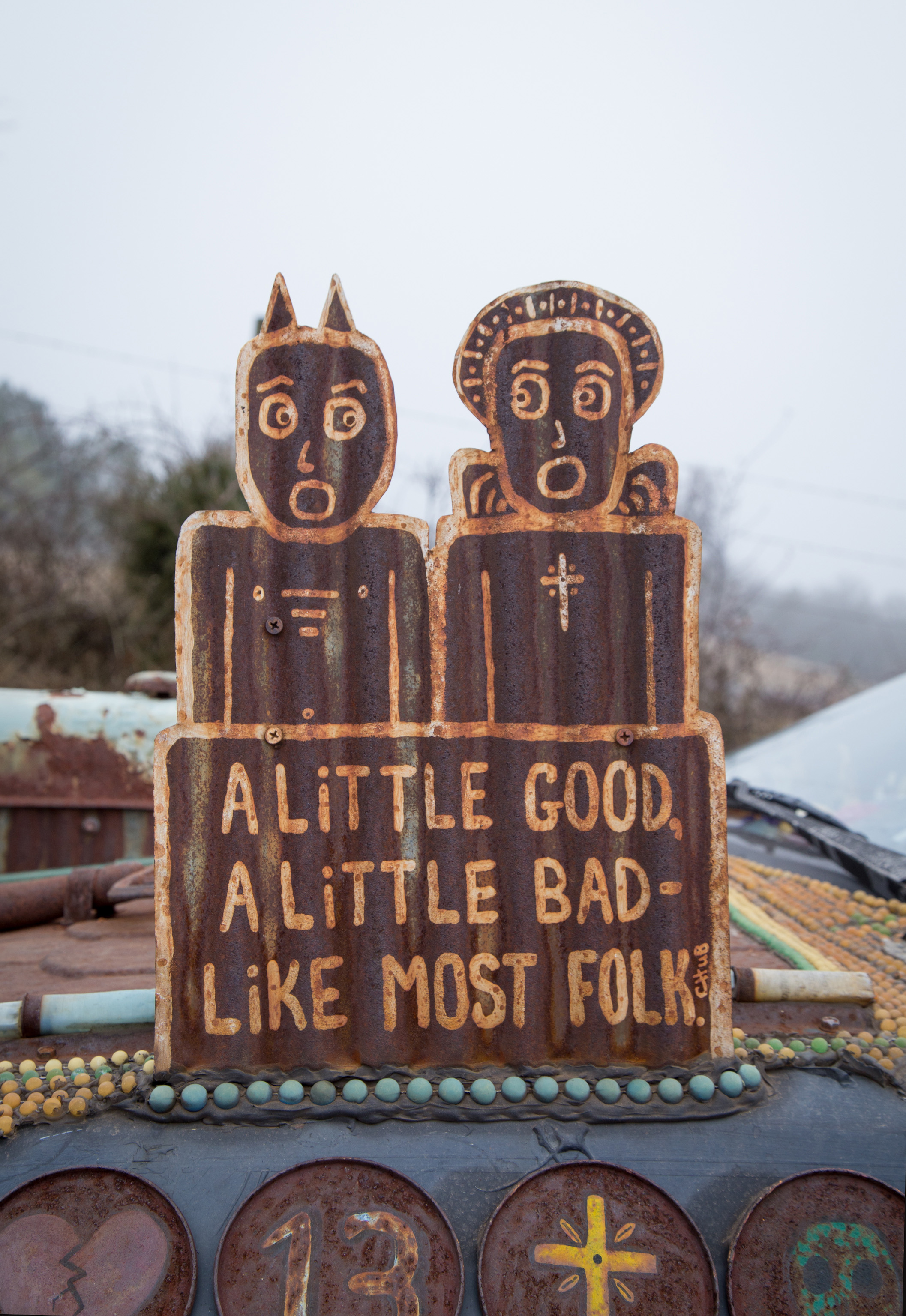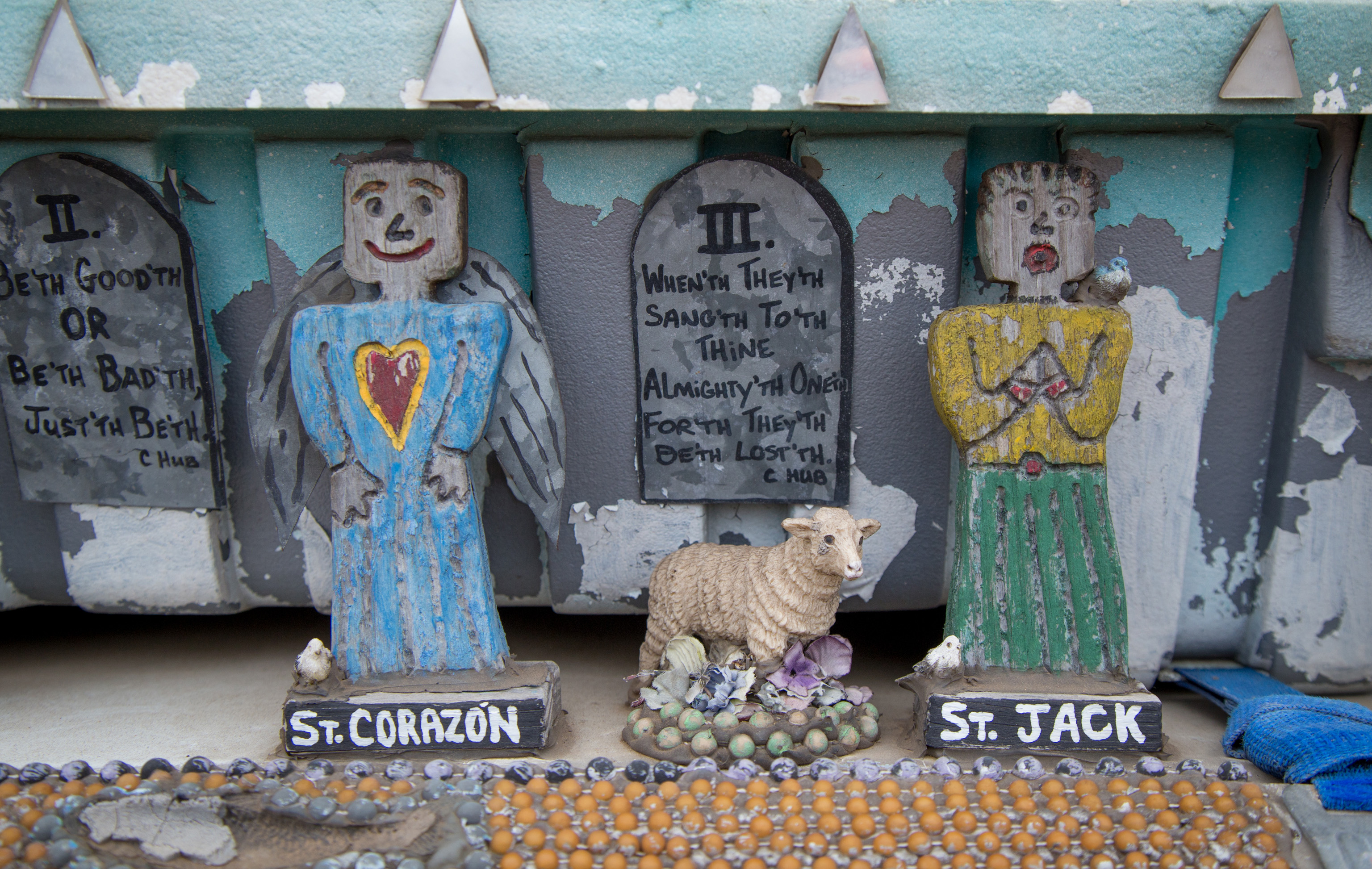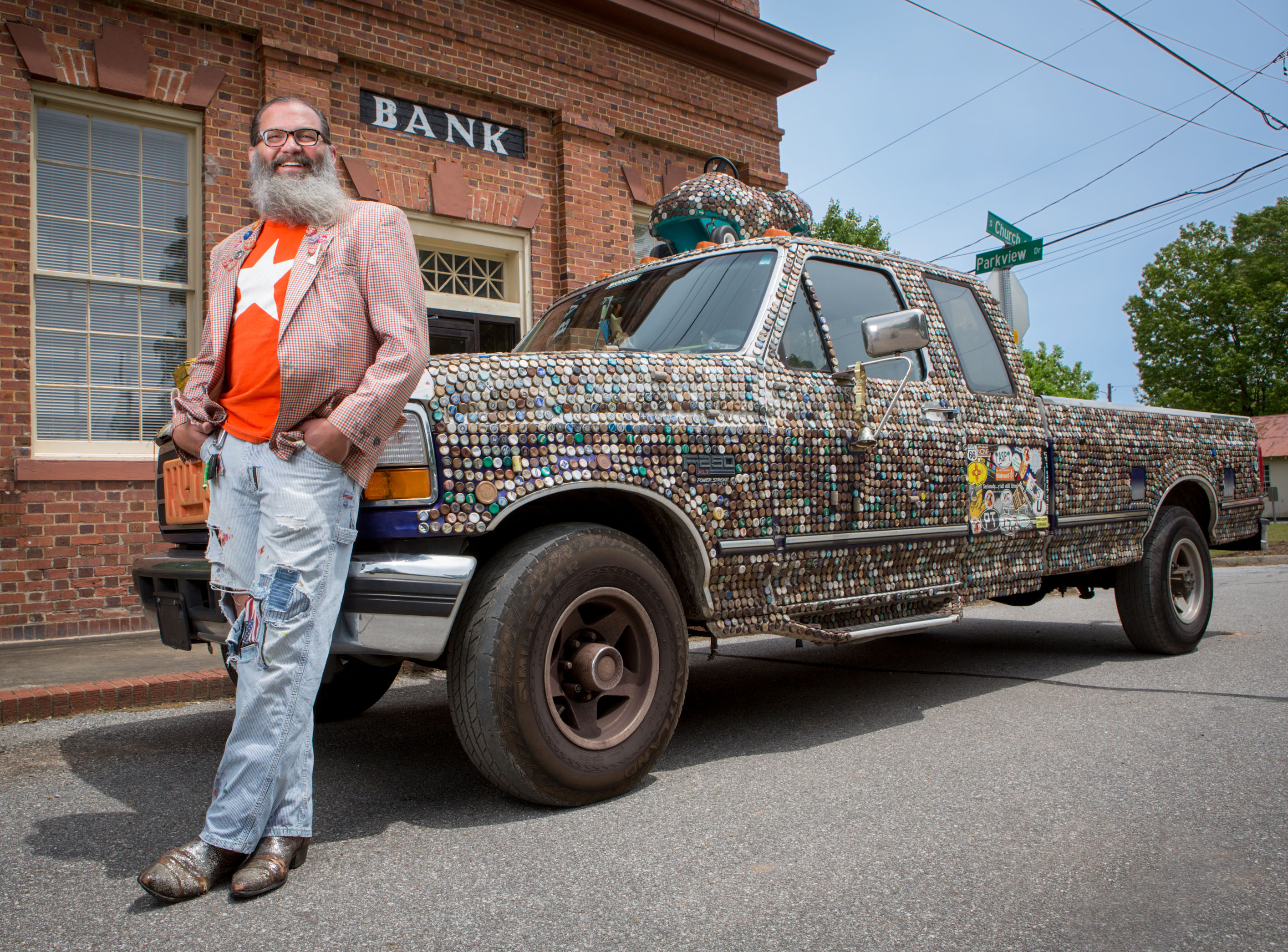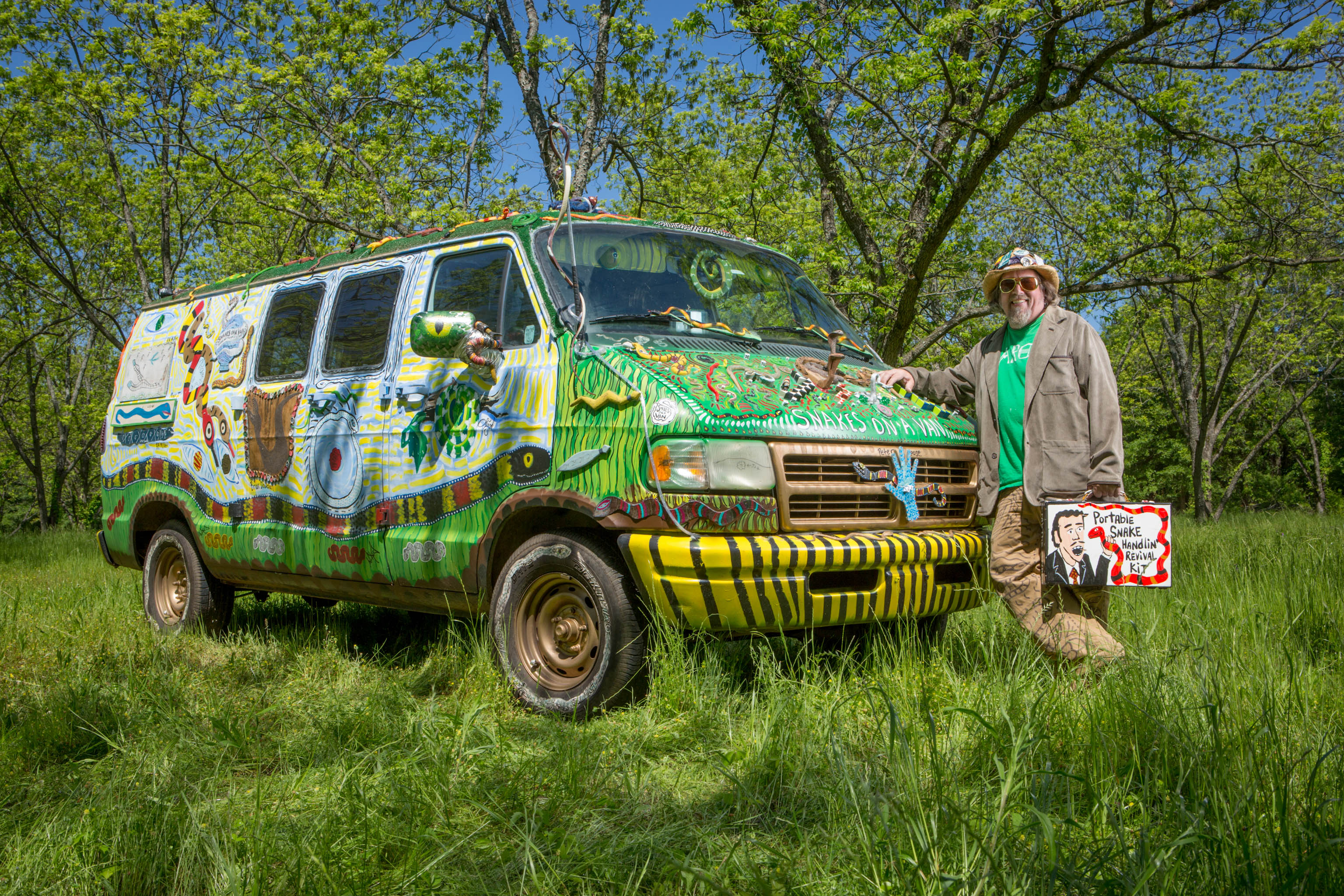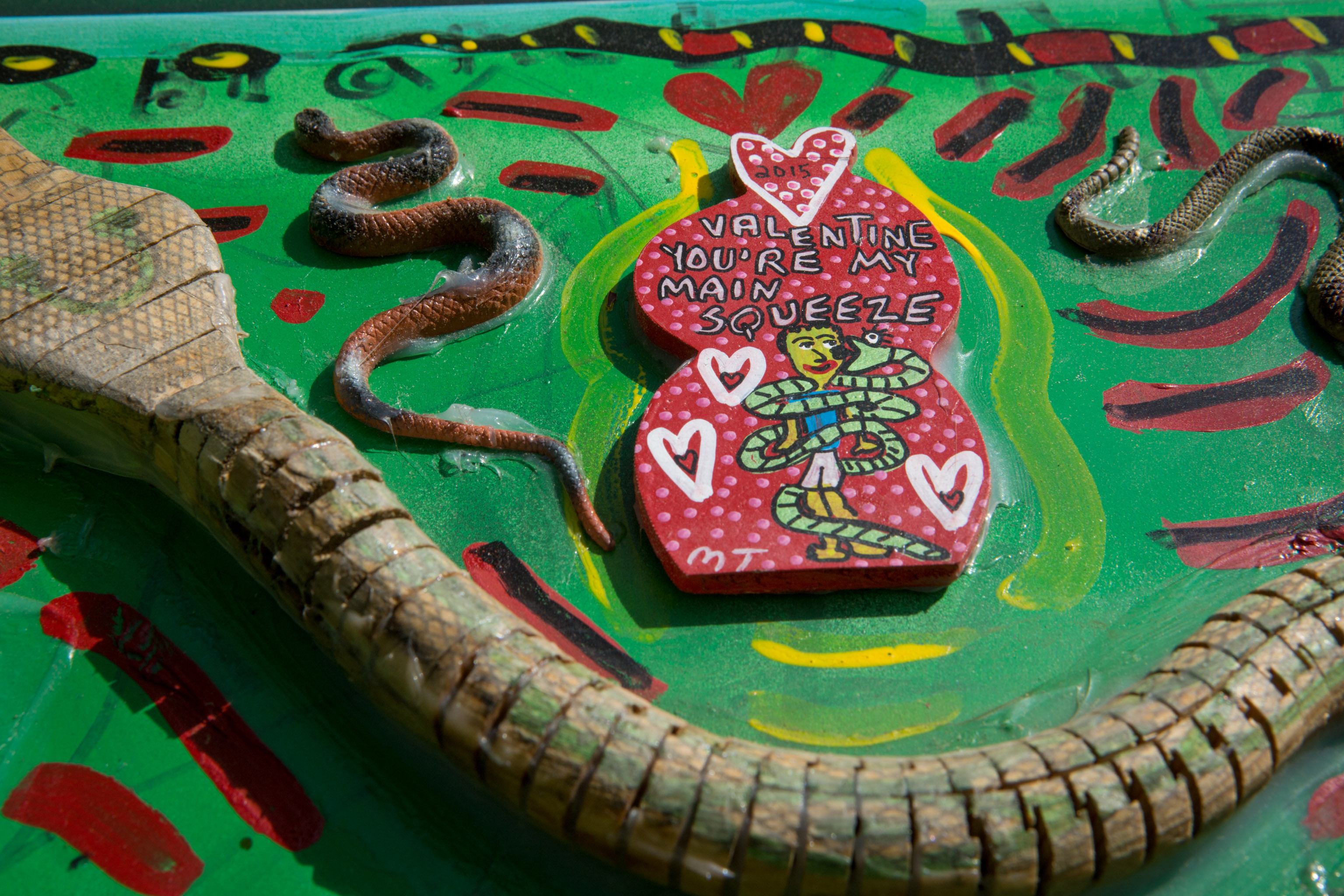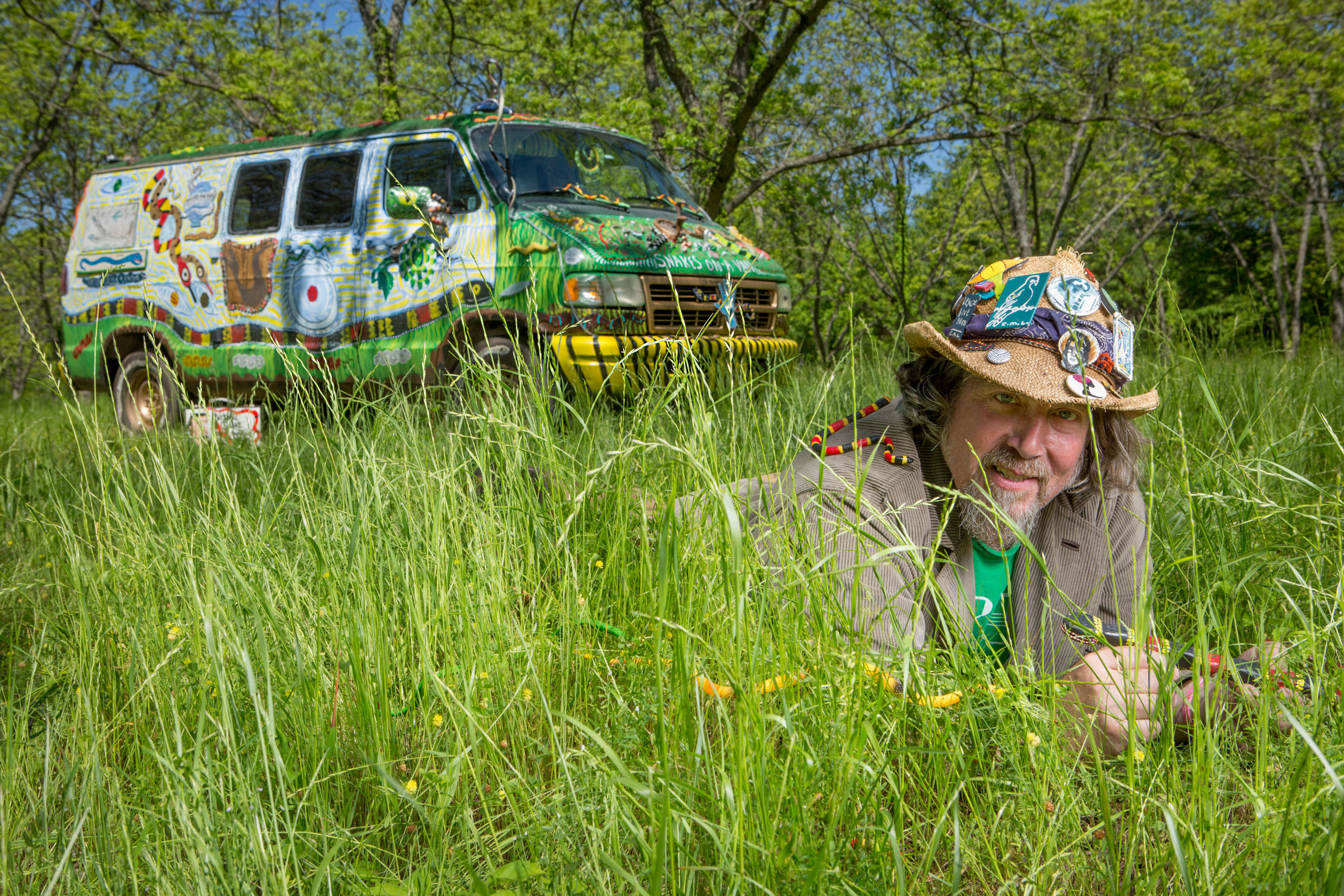Jeremiah Alec Roy Pina
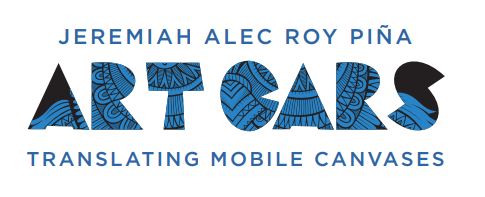
By: Cynthia Adams | Photos By: Nancy Evelyn
This year, photographer Nancy Evelyn took on an especially challenging assignment: to take a ubiquitous subject—then set about capturing that well-known object in a different light.
The assignment became a photo series, with Evelyn capturing “art cars” in the vicinity of the University of Georgia. Afterward, Jeremiah Alec Roy Piña a graduate student working in creativity studies, translated these works of art as photographed. His professor, Bonnie Cramond, is an educational psychologist, and recommended him for the creative exercise. According to Cramond, “Piña is an advanced doctoral student studying creativity who also knows a lot about cars.”
Who better to help us translate these mobile canvases?
Public art and art making is so topical that the media, including the New York Times, devote articles to this and the concept of “outsider” art. The term itself has evolved to generally include the work produced by self-taught artists. It also describes work that incorporates fantasies or work outside the mainstream, or even work that expresses unconventional ideas.
The take away may be this: few agree on what art is, whether conventional or not, especially “outsider” art. Does it happen that art exists in relation to its opposite, something posited by the New York Times this year? And this exercise posed other questions, such as, when does a mere car become an art car?
Further, why do artists create art to begin with? And why select a car as their medium in the first place?
So we turned to Piña for answers.
But first: a few thoughts about automobiles, and cars and drivers, themselves.
That sedan, van, or SUV in your driveway may not say much to you at first glance.
But take a closer look.
Cars are bound up in our human histories. Writer James Harithas says, “The history of the privately owned vehicle is fundamental to this (the twentieth) century.”
In the year 1903, critics remained stubbornly convinced that cars were a dangerous idea. One British magistrate suggested that pedestrians take aim with a shotgun if they encountered a passing motor car. The Great Gatsby drew upon the theme of a car as a vehicle for violence. But by the 1930s, the United States was transformed by more cheaply produced cars, which meant that car ownership was not merely for the wealthy. By the 1950s, the automobile was a solid mainstay, viewed now as transport from childhood to adulthood, emblematic of crossing over a threshold to young adulthood and freedom. At a certain age, taking the wheel is a rite of passage.
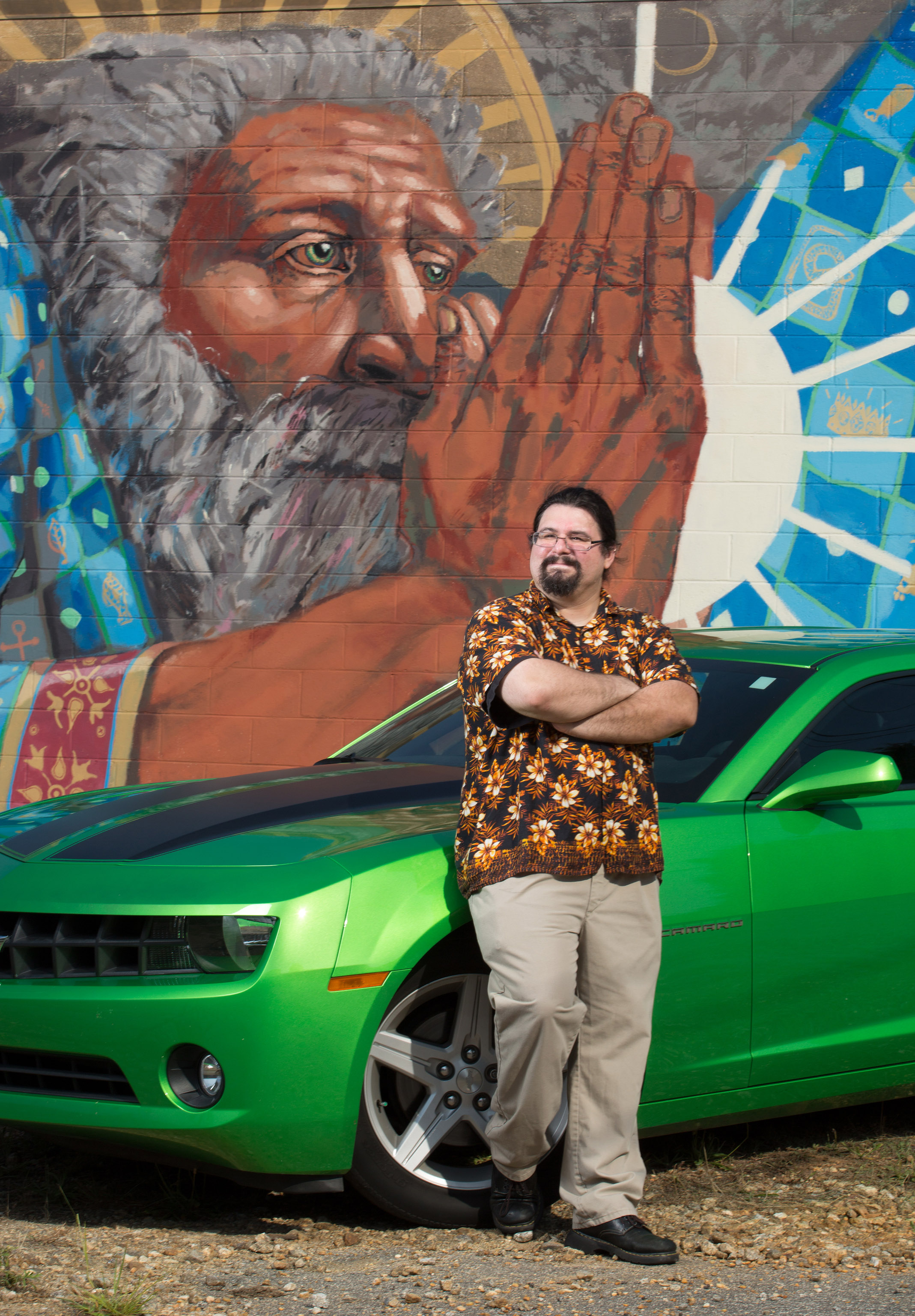
Jeremy Pina in front of St Udio mural. Originally commissioned by St. Udio metal works studio. The mural artist is Joel Rosenburg. The figure is based on the Patron Saint of Blacksmithing / Metalworking. (Perhaps St. Eligius or St Clements?)
Drivers express themselves in sometimes subtle ways. We prefer certain colors (automobile sales of gray or silver predominate at the present) and we like certain features. Americans prefer cup holders, for example. Europeans do not. We are progressively invested in our vehicles as rolling billboards. We slap bumper stickers and emblems onto our cars. New parents warn there is a “baby on board” with miniature caution signs. Marathoners proudly emblazon their cars with 26.2 and 13.1 mile decals. Come political cycles, we often declare our political allegiances or vested interests.
Yet for a creative few among us, the relationship between car and driver far exceeds this pragmatic notion of practical transportation with space for personal expression on bumpers or rear windows. The cars they drive take on a deeper, far more artistic, significance: for these expressive individuals, a car becomes a blank canvas.
For a select few, an assembly line car is insufficient to fulfill its role as an extension of the self. It isn’t just a chassis and some metal, a motor, and accessories of the moment. A car cries out to be altered, modified, and artistically manipulated.
It cries out to become a rolling art exhibit.
Take car enthusiast David Davis, who wrote in Car and Driver about his many car modifications: “I see cars as a means of self-expression—canvases for the eighth-grade automotive fantasies that never went away.”
The art world famous, such as artists Andy Warhol and Roy Lichtenstein, once designed art cars for German car manufacturer BMW. Warhol, who designed everything from album covers to cars, selling paintings of literal objects and even autographing (and selling) actual soup cans, introduced an ongoing debate concerning art in the 1960s.
The advent of pop culture, largely credited to Warhol, challenged the public’s perceptions of art and renewed the ongoing debate: What is art?
“The art car is a revolutionary extension of this history and is in the process of transforming the automobile into a potent new personal symbol,” says Harithas. He writes on the website for Houston’s Art Car Museum on Heights Blvd., which is described as dedicated to contemporary art.
“An art car is a motor-driven vehicle which a car artist alters in such a way as to suit his own aesthetic. In other words, the artist either adds or subtracts materials of his own choosing to or from the factory model or he may renovate an earlier model to revive a beauty and style that once was. The result is a vehicle which conveys new meaning through design, mechanical or structural changes, renovation, and/or the addition of new images, symbols or collage elements.”
At its simplest, the art car—half art exhibition, half vehicle— is a mobile art installation that catches our eye.
And given that they challenge our general ideas about cars as we know them, we need to make sense of seeing the familiar in such an unfamiliar way.
TRANSLATING THE CREATIVE IMPULSE AND LIFE OF THE IMAGINATION
Like art car creators, some are impelled toward creative self-expression, and to even make a study of it.
Enter Jeremiah Alec Roy Piña.
This creativity researcher comes from a richly diverse background, and is delighted by the idea of seeing the world through a creative lens. Piña is the oldest of five children, originally born on the Round Valley Nomlaki reservation in Northern California.
There are fewer than a thousand tribal members on the 32 square mile reservation near Mendocino in the town of Convelo. He explains that the Round Valley Indian Tribes, or RVIT, is his tribal designation. “I’m half Nomlaki, but because there are, and have been, so few Nomlaki for such a long time, the reservation land is shared among several intermarried tribes collectively known as the Round Valley Indians.”
Piña’s life as a study in creative adaptation was kick-started by early years as a tribal outsider, living with his Caucasian mother. “The details are hard to know,” he says quietly. “My mother was white, and not easily accepted.”
Ultimately, Piña wound up relocating to Georgia along with his mother. He became interested in creativity studies at the University of Georgia. As a doctoral student studying human imagination and creativity, Piña is exploring the phenomenon called a paracosm. The notion of a paracosm was identified in the 1980s. “That means world-building,” he explains.
The literary Bronte sisters shared an imaginary world, or paracosm, from childhood. It was an elaborate creation Piña says. In early life, he believes imaginary friends and worlds are adaptive, as he describes in the Brontes’ example. “I think the imagination can last beyond those years,” he observes.
Piña, who wears a short-sleeved navy shirt, covered with white birds, immediately mentions the creativity studies of Paul Harris.
Harris is a developmental psychologist and faculty member at the Harvard Graduate School of Education. He is frequently cited in the media for his studies of the human imagination. He says in an interview on the subject of “magical thinking”—which asked whether it was helpful for children to believe in such things as a Tooth Fairy—that when you are contemplating history, theology, or a real life garbage man, you must employ the imagination Harris writes:
“The imagination is absolutely vital for contemplating reality, not just those things we take to be mere fantasy.” In another article, Harris said, “The work of the imagination is to solve problems. It allows us to postulate alternatives.”
Now, Piña is postulating about the creative motivations of those who created art cars as photographed by Evelyn.
Evelyn’s photographs depict four art cars with their owners. Piña notes, upon first examination, “I am interested in the enthusiast culture.”
He is immediately captivated by what he sees.

ZOOMING PAST THE BLACK MODEL T: PINA’S TAKE ON THE ART CAR
Piña, who has intense dark eyes and hair, pushes his glasses back and leans into the photographs Evelyn fans before him. He recognizes the true trajectory of these elaborately adorned art cars—they are fast on the track of creativity.
Speaking in generalities, Piña offers this immediately about art cars:
“My general impressions? One is humor. Each of them is trying to make a statement. Think of the ‘Snakes on a Plane’ fi lm. A parody. The Hot Wheels car is some work. Maybe doing some form of racing?”
In Piña’s view, each of the art car creators is taking a risk. “It’s a vulnerable position to be in…I really salute them on this!” He adds, “We can all benefit from them if we understand what they bring. They engender a pioneering spirit that is also part of the American spirit.”
“THE HEAVEN AND HELL” CAR OWNED BY CHRIS HUBBARD
“Seldom do I get a chance to encounter objects as symbolically rich as the Heaven and Hell car. This vehicle seems to me an attempt to approach concepts of syncretism, aesthetics, and the underlying moral themes associated with good and evil as a form of mobile altar or tabernacle. Which is funny, really, because some Judeo-Christian tabernacles were mobile, so it’s an echo of history?
“Underlying the symbols themselves is a sort of slapdash or, for lack of a better term, devil-may-care mode of presentation which is cool, weird, and fun all at once,” says Piña. “Because it concerns religion, it’s controversial and it grabs the imagination. I can get a sense that not every place that Hubbard has driven through with the Heaven and Hell car has been open-minded to the work, and maybe that’s the point. By putting religious icons (and not just religious icons, but strange religious icons) out there where the world can see them, Hubbard is starting a conversation with the public. It’s the type of thoughtful creative risk-taking that I can really appreciate.” Then he elaborates further.
“The Heaven and Hell art car,” observes Piña, which was, incidentally, created by a scientist, “looks like he has created saints. It’s an idiosyncratic pantheon. These are all these deities he knows about. It’s a drivable shrine.”
- Chris Hubbard – Heaven & H@ll car
- Chris Hubbard – Heaven & H@ll car
- Chris Hubbard – Heaven & H@ll car
“BOTTLE CAPS” OWNED BY JIMMY STRAEHLA (THE “CAP MAN”)
“There’s something nostalgic about bottle caps,” says Piña. “They’re somehow fascinating despite being relatively mundane. They’re basically junk, but interesting junk and they remain useful beyond their allotted span because they hold our interest.
“Straehla’s Bottle Caps truck, sheathed as it is in old bottle caps, is an amalgamation of that nostalgia and fascination. If you look at it in the right light, it almost looks like the truck is bejeweled, or perhaps frosted in rusted metal and coated with the strange, half worn symbols that carry with them an infinitesimally tiny speck of history. Every time I look at the truck, I find my eye drawn to some new detail and I wonder if there’s a story I’m missing. It may not actually be the case that each of the bottle caps is as important as I imagine, of course, but it does speak to a certain sentimental authenticity and intrinsic motivation on behalf of the artist to make us feel like there just might be.”
According to Evelyn, the car was featured in Houston at the art cars parade.
“All of them want to say something,” says Piña. “There’s another aspect of time in all of this…because most of these people grew up in a period where they hold onto their vehicle.”
- Jimmy Straehla – Cap Man. Photographed with his Cap Truck in hometown Winterville, GA.
- Jimmy Straehla – Cap Man. Photographed with his Cap Truck in hometown Winterville, GA.
“HOT WHEELS” OWNED BY LIZ LARSON
“I don’t know her relationship with Hot Wheels,” says Piña. “But this is a sharp quip.
“I like to think about this one first because it’s the one that stands out the most. Unlike some of the other art cars I’ve seen, the creativity of the Hot Wheels car isn’t in the elaboration of the design, nor necessarily in the authenticity of the work, but it instead comes from the humor associated with the message emblazoned on the vehicle. Such a simple thing, and elegant in its own way.
“It is the essence of a bon mot, a quip or witty statement, which might be prized not on the merit of its complexity, but for its sophistication and self-awareness. In the study of creativity, we sometimes emphasize the originality of an idea at the expense of the equally important, though sometimes less glamorous, requirement of appropriateness. Larson’s Hot Wheels car is an example of why this overly simplistic, novelty-preoccupied way of looking at creativity doesn’t always capture truly sparkling and inventive modes of self-expression which are excellent precisely because they say the right thing in just the right way.”
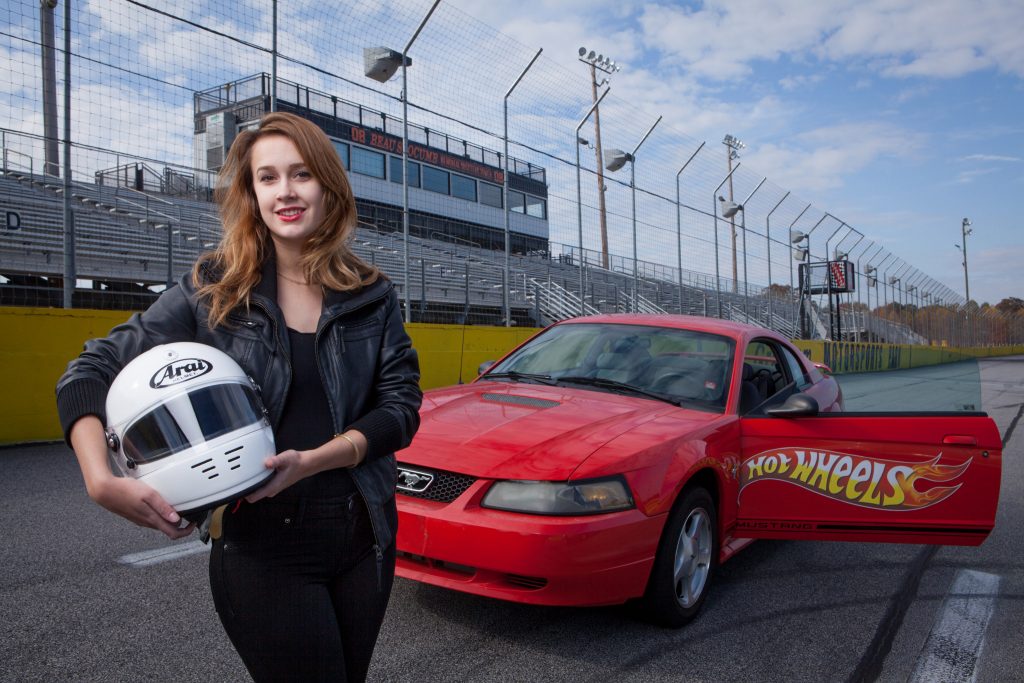
Liz Larson – Hot Wheels car (Art Cars)
“SNAKES ON A VAN” OWNED BY PETER LOOSE
“I’ll be honest, unlike most people I know, I don’t have a particular aversion to snakes,” says Piña. “And I think it’s for that reason I get a sense of the simple, optimistic expression of avidity that lies at the heart of Loose’s artistic work. Like with Hubbard’s Heaven and Hell car, the art car in question is full of details, but in contrast I don’t get a sense that Loose is trying to be particularly controversial. Rather, I get an almost herpetological feeling about the vehicle, as if Loose were evoking the image of some rogue natural philosopher rambling around and instructing folks about all the good snakes do for the world.
“Just looking at the variety of snakes presented and the attention to detail in the markings and crisp presentation of each icon, I am willing to bet that Loose has an advanced knowledge of snake physiology and can point out particular species embedded along the side of the vehicle. This speaks to both the creative thinking skills we refer to as fluency, that is to say the ability to produce many ideas along a theme, and elaboration, or overall complexity, which accounts for the intricacy of the work.
“The pennies on the truck—decorated with head side up (known as copperheads) are an extension of this person’s story.” Piña continues, “the role of the car—it’s a piece of the American legend. The Model T only came in black,” he laughs, “and we have been reacting against that since it happened.” Scanning the cars one by one more intensely, Piña adds, “All of this says we love diversity. These people say it’s not enough to just have a crazy color car.”
- Peter Loose, Snakes on a Van (art car)
- Peter Loose, Snakes on a Van (art car)
- Peter Loose, Snakes on a Van (art car)
- Peter Loose, Snakes on a Van (art car)
DREAMING OF A CLASSIC
Pina appreciates nonconformity. It so happens that he drives a very colorful car himself—not an art car, but definitely one that makes a statement. Piña’s bright green Chevrolet Camaro is meant to be noticed. His “around town” practical car is a 2004 Volkswagon Beetle, which he describes as dingy gray.
Does Piña have a dream car of his own, given his personal love of vehicles? In fact, he does.
“My dream car would be a 1967 Jaguar E-Type Hearse, which is the car from the movie Harold & Maude. If not that, a 1969 GTO Judge in Inferno Red would be my second choice. The first is classic because it tells a unique story in the film, the second is a classic because it tells a story about American cars during the height of the muscle car era.”
For Further Reading:
The Art Car Museum: www.artcarmuseum.com/
Chris Hubbard: www.heavenandhellcar.com/
Liz Larson: flagpole.com/arts-culture/everyday-people/2012/08/01/everyday-people-10
Peter Loose: www.marciaweberartobjects.com/loose.html
Jimmy Straehla: thecapman.us/
Jeremiah Piña: www.flagpole.com/arts-culture/calendarpicks-1/2014/08/27/joel-rosenburg-mural-reception




